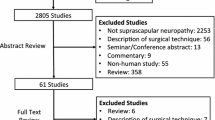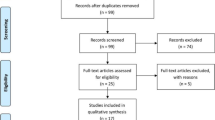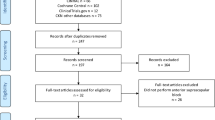Abstract
Suprascapular nerve block (SSNB) is a popular treatment for shoulder pain. To date, studies undertaken mainly describe the methods of performing the technique or are trials examining its efficacy. As a result, the numbers of blocks reported are small and therefore confidence in the safety of the procedure must be limited. Furthermore, although most studies report pain reduction using visual analogue scales, there are no reports of patient satisfaction with the subsequent pain relief. This study aimed (1) to determine the safety of SSNB in a population of patients presenting in rheumatology practice and (2) to determine the patient satisfaction with the pain relief. From 2003 to 2009, 1,005 SSNBs were undertaken by rheumatologists in several centres in South Australia. All patients who had at least one SSNB performed were identified. Case notes were examined and patients were contacted to identify any side effects from the procedure. Patients were also asked to report their satisfaction with the pain relief. Of the 1,005 nerve blocks performed, there were a total of six side effects. They were three episodes of transient dizziness, two episodes of transient arm weakness and one episode of facial flushing. There were no serious side effects reported. Patient satisfaction with the pain relief was high, with over 80% of respondents being satisfied or very satisfied with the result. SSNB is a very safe procedure in the outpatient setting, even among frail, elderly patients. Patients rate the satisfaction with the pain relief highly.
Similar content being viewed by others
References
Shanahan EM, Ahern MJ, Bresnihan B, Smith MD, FitzGerald O (2003) Suprascapular nerve block using bupivacaine and methylprednisolone in chronic shoulder pain. Ann Rheum Dis 62(5):400–406
Brown DE, James DC, Roy S (1988) Pain relief by suprascapular nerve block in gleno-humeral arthritis. Scand J Rheum 17:411–415
Dahan T, Fortin L, Pelletier M, Petit M, Vadeboncoeur R, Suiissa S (2000) Double blind randomized clinical trial examining the efficacy of bupivocaine suprascapular nerve blocks in frozen shoulder. J Rheum 27:1464–1469
Emery P, Bowman S, Wedderburn L, Grahame R (1989) Suprascapular nerve block for chronic shoulder pain in rheumatoid arthritis. BMJ 299:1079–1080
Gado K, Emery P (1993) Modified suprascapular nerve block with bupivocaine alone effectively controls chronic shoulder pain in patients with rheumatoid arthritis. Ann Rheum Dis 52:215–218
Jones DS, Chattopadhyay C (1999) Suprascapular nerve block for the treatment of frozen shoulder in primary care: a randomized trial. BJ of GP 49:39–41
Ritchie ED, Tong D, Chung F, Norris AM, Miniaci A, Vairavanathan SD (1997) Suprascapular nerve block for postoperative pain relief in arthropscopic shoulder surgery: a new modality? Anesth Analg 84:1306–1312
Vecchio P, Adebajo A, Hazelman B (1993) Suprascapular nerve block for persistent rotator cuff lesions. J Rheum 20:453–455
Dangoisse MJ, Wilson DJ, Glynn CJ (1994) MRI and clinical study of an easy and safe technique of suprascapular nerve blockade. Acta Anaesthesiol Belg 45(2):49–54
Shanahan EM, Smith MD, Lott CW, Slavotinek J, Weatherall M, FitzGerald O, Ahern MJ (2004) Suprascapular nerve block in chronic shoulder pain—are radiologists better? Ann Rheum Dis 63:1035–1040
Solomon DH, Bates DW, Horsky J, Burdick E, Schaffer JL, Katz JN (1999) Development and validation of a patient satisfaction scale for musculoskeletal care. Arth Care and Res 12(2):96–100
Wertheim HM, Rovenstine EA (1941) Suprascapular nerve block. Anesthesiology 2:541–545
Neal JM (2004) In: Rathmell JP, Neal JM, Viscomi CM (eds) Upper extremity blocks, requisites in anaesthesiology: regional anesthesia. Elsevier, Philadelphia
Boardman ND 3rd, Cofield RH (1999) Neurological complications of shoulder surgery. Clin Orthop Relat Res 368:44–53
Laine L (1996) Nonsteriodal anti-inflammatory drug gastropathy. Gastrointestin Endosc Clin N Am 6:489–504
Ernst E, Pittler MH (2001) Assessment of therapeutic safety in systematic reviews: literature review. BMJ 323:526
Hudak PL, Wright JG (2000) The characteristics of patient satisfaction measures. Spine 25(24):3167–3177
Disclosures
None.
Author information
Authors and Affiliations
Corresponding author
Rights and permissions
About this article
Cite this article
Shanahan, E.M., Shanahan, K.R., Hill, C.L. et al. Safety and acceptability of suprascapular nerve block in rheumatology patients. Clin Rheumatol 31, 145–149 (2012). https://doi.org/10.1007/s10067-011-1813-3
Received:
Revised:
Accepted:
Published:
Issue Date:
DOI: https://doi.org/10.1007/s10067-011-1813-3




